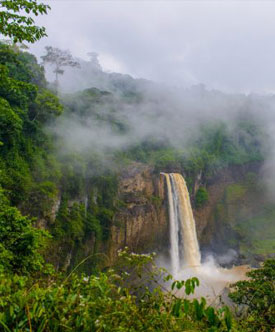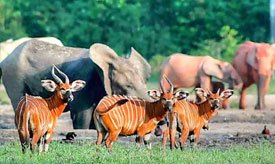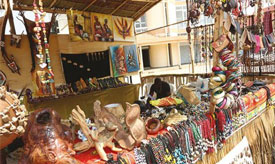About Cameroon
Cameroon is situated in Central Africa, at juncture of the Gulf of Guinea.
It is bounded on the North by Chad, on the East by the Central Africa Republic, on the South by Congo, Gabon and Equatorial Guinea and on the West by Nigeria.
Cameroon is a country with several major towns, amongst which are YAOUNDE, the political capital of the country with about one million inhabitants.
DOUALA, which is the major economic city, has more than two million inhabitants. The other main towns are GAROUA, BAFOUSSAM, MAROUA, BAMENDA etc.
Population
Cameroon has more than 240 tribes which are found in three main ethnic groups; Bantus, Semi-Bantus and Sudanese. The most notable tribes are:
BANTUS: Beti, Bassa, Bakundu, Maka, Douala, Pygmies...
SEMI-BANTUS: Bamileke, Gbaya, Bamoun, Tikar...
SUDANESE: Fulbe, Mafa, Toupouri, Shoa-Arabs, Moundang, Massa, Mousgoum...
Languages
Cameroon is home to 230 languages. These include 55 Afro-Asiatic languages, two Nilo-Saharan languages, 4 Ubangian languages, and 169 Niger-Congo languages.
French and English are the official languages, which are spoken by 70% and 30% of the population respectively.
Spanish and German are equally spoken by a few city-dwellers.
Religion
Cameroon is a secular state. Two major religions have followers ; Christianity and Islam. Animism is also widely practised. Approximately 70 percent of the population is at least nominally Christian, 20 percent is nominally Muslim and 6 percent practise traditional indigenous religious beliefs. Traditional indigenous religious beliefs are practised in rural areas throughout the country...
Public Holidays
Religious:
Good Friday, Easter, Ascension, Pentecost, Assumption, Christmas, End of Fasting, Feast of the Ram.
Secular:
New Year,
Youth Day (11th February),
Labour Day (1st May),
National Day (20th May).
Touristic Season
Besides the shooting season which is practised in the northern part of the country from November to May, all other tourist activities can be undertaken throughout the whole year. The best time to visit Cameroon is during the slightly cooler and drier months of November to February. The Saharan harmattan wind reduces temperatures and reduced humidity, although it does bring a haze of dust.
Climate
Dry and rainy seasons alternate in the country, with the dry season generally going from November to April. Temperatures range from 23 to 31oC in January to 21 to 35oC in July.
ISO code is CM
Time: 1 behind GMT
The south is hot and dry November-February. The main rainy season is June-October. Temperatures in the north vary...
The 10 Regions
Regional capital : Ngaoundere
Population: 681 362 inhabitants
Surface area: 63 701 km2
Number of Divisions: 5
Density: 10.7inhabitants/km2
Tourist Attractions:
Water catchment region of Cameroon, this Region is full of crater lakes, cattle ranches, underground minerals, wild animal species and several caves.
Regional capital: Yaounde
Population: 2 272 259 inhabitants
Surface area : 68 953 km2
Number of Divisions : 10
Density: 32.96 inhabitants/km2
Tourist Attractions:
Seat of the political capital of the country. So many interesting natural sites such as the caves of Akok-Bekoe, monuments of colonial figures such as Charles Atangana, the Chief of the Ewondos, and the forest reserve of Ottomo (Ngoumou).
Regional capital: Bertoua
Population: 711 651 inhabitants
Surface area: 109 002 km2
Number of Divisions: 4
Density: 6.53 inhabitants/km2
Tourist Attractions:
Visitors can undertake to cross the vast forests that cover this Region. The visitor can easily get into camps set up for pygmies, enjoy the biodiversity in the Dja reserve and get a view of the Gbaya and Maka cultures.
Regional capital: Maroua
Population: 2 553 389 inhabitants
Surface area: 34 263 km2
Number of Divisions: 6
Density: 74.52 inhabitants/km2
Tourist Attractions:
Apart from the numerous wild animals which make this Region a pleasurable destination for hunting, there is a wide variety of traditional rulers' palaces, lunar landscape in Kapsiki, caves and lakes with a high concentration of hippopotamus, handicraft shops and horse displays. Three national parks in this Region namely; the national park of Kalamalou? at Kousseri, the national park of Waza at Waza and the national park of Mozogo at Koza.
Regional capital: Douala
Population: 1 861 463 inhabitants
Surface area: 20 248 km2
Number of Divisions: 4
Density: 91.93 inhabitants/km2
Tourist Attractions:
The 'ngondo' festival is deeply routed here, and other seaside pastimes abound as the indigenes of this Region celebrate their intimate relation with water. The entry point into the country for most visitors and harbours a lot of historic monuments. Natural attractions such as the waterfalls of Ekom Kam, lake Ossa and large commercial plantations.
Regional capital: Garoua
Population: 1 145 038 inhabitants
Surface area: 66 090 km2
Number of Divisions 4
Density: 17.33 inhabitants/km2
Tourist Attractions:
The visitor has a wide variety of options, ranging from national parks, hunting area, horse displays, traditional palaces to the attractions of the Benou? river with a dam at Lagdo and several archaeological sites where fossil remains of dinosaurs have been found. The national parks here include those of the Benou?, Boubandjida and Faro.
Regional capital: Bamenda
Population: 1 702 559 inhabitants
Surface area: 17 300 km2
Number of Divisions: 7
Density: 98.41 inhabitants/km2
Tourist Attractions:
Hilly and mountainous Region with grass field landscape, the visitor here has a wide variety of traditional palaces, waterfalls, crater lakes, handicraft shops and other cultural artefacts which make it a regular tourist destination.
Regional capital: Bafoussam
Population: 1 843 518 inhabitants
Surface area: 13 892 km2
Number of Divisions: 8
Density: 132.7 inhabitants/km2
Tourist Attractions:
Mountainous Region with many traditional palaces, crater lakes and colourful funeral ceremonies (between the months of November and February every year), and the 'ngoun', a great annual festival of the Bamoum people.
Regional Capital: Ebolowa
Population: 514 336 inhabitants
Surface area: 47 191 km2
Number of Divisions: 4
Density: 10.9 inhabitants/km2
Tourist Attractions:
Area with dense forests and small islets, visitors here can also enjoy the beaches along the coast and the Lobe waterfalls. There are also abundant reserves of sea food.
Regional capital: Buea
Population: 1 153 125 inhabitants
Surface area: 25 410 km2
Number of Divisions: 6
Density: 45.38 inhabitants/km2
Tourist Attractions:
Home of the highest Mountain in the country and in West Africa, Mount Cameroon. The coastline here also has attractive beaches. Further inland, the Korup national park has a wide variety of rare animals and trees.
TOURISM IN CAMEROON
Cameroon is a choice destination with a lot of attractions for any visitor. The country has a lot of natural attractions and many other phenomena that are not found anywhere else in the world, making it possible to have various categories of tourism.
Situated at the heart of Africa, indeed straddling West Africa and Central Africa, and stretching from the elbow of the Gulf of Guinea on the coast of the Atlantic Ocean, going through evergreen forests which gradually fade into grass land savannah until it reaches the sandy regions of Lake Chad, Cameroon has features which are found in all parts of Africa.



The 400 km long coastline of the Atlantic Ocean is very suitable for tourism, with a lot of attractions like colourful bays, rich sandy beaches, a variety of small islets, mangrove vegetation and waterfalls that plunge directly into the ocean.
Fishing goes on in all the settlements along the coastline, carried out by individual and commercial fishermen. Any visitor can take a try at fishing. A wide variety of fishes can is also to be found in the many rivers which can be found throughout the country.
There are seven national parks in Cameroon, with the most interesting and properly maintained one being the Waza Park in the Far North Region. These parks have a large number of the various animal species found in Africa ( elephants, lions, giraffes, rhinoceros, panthers, buffalos, antelopes, hippopotamus, hyenas, gorillas, cheetahs etc...). Besides the national parks wherein hunting is prohibited, there are 14 hunting zones in the northern part of the country with more than 500 km of motorable roads. Cameroon is the place of choice in West and Central Africa for safari tourism as the national parks and other animal reserves like Boubandjida in the Adamawa Region are properly preserved.
As a result of the concerns for the preservation of the environment, measures have been undertaken to classify and protect some natural sites for various purposes, including scientific, ecological and tourist activities. Some of the prominent ones are:
The Korup National Park which has plant species that are more than one million years old.
Dja Reserve, which is classified among humanities heritages by UNESCO.
Mount Cameroon, which is 4,070 m highand has vegetation which dates back to the Quaternary period and has been accepted for international mounting-climbing events. It is an ecological site with remarkable potential that is being improved by the German NGO, "GTZ". Mount Cameroon is still an active volcano with the most recent eruption occurring in March 2000. The rainfall in this area is also very high, especially at Debuncha on the West Coast.
The Site of Mayo-Rey where footprints of dinosaurs are still visible.
The population of Cameroon is made up pf more than 200 ethnic groups with different customs and traditions, some of which have survived till date, especially in the north and west of the country.
A lot of diversity can be observed in the way of life, the folklore, the religion, housing and culinary habits. The oval houses of the Massa people in the north are unique in design in the world.
The historical artefacts that abound in Cameroon are a testimony of the creative nature of the people, while the monuments and other vestiges of past events attest to the colonial history of the country. English and French are a remarkable indication of the bilingual culture of Cameroon.
Mountaineering is a good pass time, as Mount Cameroon, Mount Manengouba offer a lot of hospitality. The Climatic centre in Dschang provides a place for a quiet holiday.
The major cities of Yaounde and Douala, with infrastructure of international standing (conference centres, international airports, hotels etc), are the main centres of conference and business tourism.
